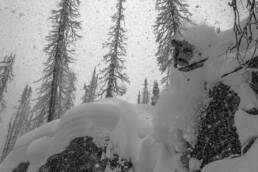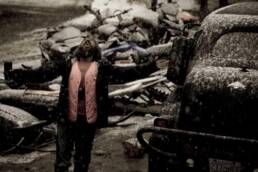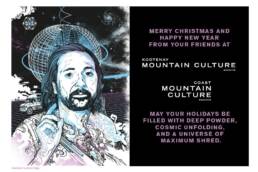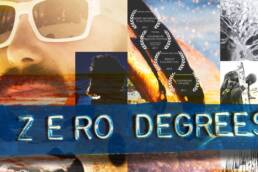For those who love winter in the high mountains, loss of snow, increased probability of avalanches and melting glaciers are all fearsome outcomes of climate change.Until Porter Fox’s book, Deep: The Story of Skiing and the Future of Snow, however, few had tried to document the relationship between skiers and the emerging fate of their mountain playground. KMC interviews the author about his quest to discover the truth.
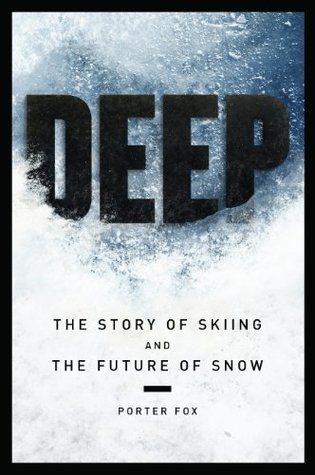 If you’re a winter sports enthusiast, it’s the story you don’t want to read. And it’s a tale fewer would ever want to write. But for long time ski writer and editor Porter Fox, who’s been the features editor at Powder magazine since 1999, the lure to figure out what’s happening to our winters was too strong. In his recently released book, Deep: The Story of Skiing and the History of Snow, Fox goes straight to the heart of how climate change is currently affecting snow in our mountains and the soul of skiers and snowboarders who might just be winter’s greatest heroes.
If you’re a winter sports enthusiast, it’s the story you don’t want to read. And it’s a tale fewer would ever want to write. But for long time ski writer and editor Porter Fox, who’s been the features editor at Powder magazine since 1999, the lure to figure out what’s happening to our winters was too strong. In his recently released book, Deep: The Story of Skiing and the History of Snow, Fox goes straight to the heart of how climate change is currently affecting snow in our mountains and the soul of skiers and snowboarders who might just be winter’s greatest heroes.
Growing up in Maine and falling in love with the dirtbag skiing lifestyle after moving to Jackson Hole, Wyoming, Fox has become one of the ski world’s most prolific writers. He has travelled to all of the world’s significant ranges, penning stories on destinations, characters and issues for titles like Powder, Outside, Men’s Journal, The New York Times Magazine and National Geographic Adventure.
In Deep, Fox paints a meticulously researched picture of snow’s future and why mountain enthusiasts need to band together to effect change. While the situation is dire, he says there is still hope. KMC Editor-in-Chief Mitchell Scott caught up with Porter Fox at his home in Brooklyn, New York.
[divider]
ANYTHING MORE THAN TWO DEGREES CELSIUS AND YOU’RE LOOKING AT WIDESPREAD FAMINE, WIDESPREAD WATER SCARCITY, MASSIVE POPULATIONS MOVING . . .
[divider]
KMC: This is obviously a massive topic to tackle. As someone who has travelled the world and written about some of its best ski destinations, what really inspired you to take it on? It must have been daunting when the idea first clicked, but what was that moment where you said to yourself, “Okay, I have do this.”?
Porter Fox: It started with a couple of skiers in Jackson Hole who called me up and said, “Hey, will you do a book on climate change and skiing?” And so I looked into it, and that moment you’re talking about came pretty soon after I started digging into the National Snow and Ice Status Centre website, NASA, NOAA, and the IPCC website, where I just read the basic statistics that everybody agrees on. It was the timeline along which these changes were happening and were predicted to continue happening that really struck fear into my heart. Right there it went from being a project that somebody wanted me to do, to being a real mission to find out exactly what was going on and how much time we actually have. And so I guess that’s the closest answer to your question I can think of; it was sort of a statistical realization this wasn’t a futuristic thing people will have to deal with in 200 years. It was something that needed to be addressed in the next 10 to 20 years or else it’s going to be really bad.
What year was this?
The spring of 2012.
Is Deep a precedent-setting book?
Is there another body of work like this that tries to bridge the gap between climate change and skiing? There wasn’t anything, and I’m not saying that to say I was a pioneer. There was a lot of frustration on my part because I couldn’t find any information. I really had to work with raw data right from the start, interpreting graphs from various labs and science facilities around the world. So it was good for the book in that it really was the first, but it made research incredibly complicated.
Having immersed yourself in this, what did you find scary?
I think it’s important to realize that if the Earth warms more than two degrees Celsius this century, you’re looking at a catastrophic situation. I was very laissezfaire with these numbers when I first started reading about them. I was thinking, “ Oh two to four, four to six,” you know, just kind of writing it down. I was talking to Auden Schendler, the vice-president of sustainability at Aspen Ski Co. who said to me not to treat these numbers quite so casually. You need to understand that anything more than two degrees Celsius and you’re looking at widespread famine, widespread water scarcity, massive populations moving and migrating north into places where they can survive, potential conflicts with political borders, potential complete collapse of the world economy, really devastating stuff. PricewaterhouseCoopers had a statistic that said we’ve got a 50-50 chance of keeping warming below two degrees Celsius, if we decarbonize six times faster than what we’re doing right now. And that’s from a pretty conservative institution. Basically, if one thing came out of my research, it’s that we have to try to stop the world from warming more than two degrees or this is just all for not.
The story starts with the avalanche that happened in Washington State’s Tunnel Creek, at Stevens Pass, in 2012 where important people in the ski community passed away. It provides a compelling narrative to keep readers interested, but why did you start there? What do avalanches and climate change have in common?
There are a few answers to that. First of all, every avalanche forecaster and many climatologists that I spoke with made a point of explaining how avalanche danger is going to spike as the temperature rises—in a very dramatic way. One ski patrol at Big Sky Resort [in Montana] actually said that climate change gave him job security because avalanches were certainly not going away; they were just going to get worse. That comes with fewer storms but more intense storms, a four-foot dump instead of a two-foot dump. And then you’re getting rain on snow events up to 12,000 feet, and then you’re getting long periods of sunshine and no precipitation in between storms of which all are bad for avalanches. Simultaneously, I was looking for a way to tell the story of skiing because the book isn’t just about snow. It’s about the story of skiing and the future of snow. The characters in the Tunnel Creek avalanche, both the victims and the people that were there, epitomize that deeply passionate skier so perfectly that it was a really good chance to explain to the general public how passionate skiers really are about their sport. It so happens that there are some similarities with the actual avalanche: the way it happened, the kind of weather events that led up to it. There were some similarities between that and between what these avalanche forecasters were telling me what to expect in the future: a long period between storms, a very intense storm, a rain event that goes high up on the mountain, so all of those factors combined made it a good match to start the book with.
Mitchell Scott
Mitchell Scott is the Editor-in-Chief and co-publisher of Kootenay Mountain Culture Magazine.
Related Stories
Cold Rush Movie
Here it is. The highlight real wrap up of one of the coolest ski events in the world today. And it all happens in the…
Cold Rush – Behind the Scenes
Sure, there was a boatload of photographers and cinematographers at the Red Bull Cold Rush. And then there was me, with…
Red Bull Cold Rush is On!
The backwater shred tap is turned on full. Retallack Lodge, Red Bull and Freeride Entertainment have employed the mind…
Red Bull Cold Rush Wrap Up
Karl the Gnarl of Nelson, BC. The man that keeps Retallack (and the Kootenays) so dang cool.. Red Bull Cold Rush has…
Merry Christmas People
We here at Kootenay Mountain Culture Magazine would like to put out a big giant snow filled hug to everyone who's been…
Cold Shot Multi-Media Faceoff
Kootenay Mountain Culture Magazine hosted the 5th annual Cold Shot Faceoff, during the Coldsmoke Powder Fest last week.…


